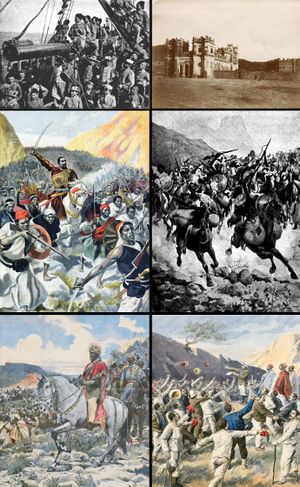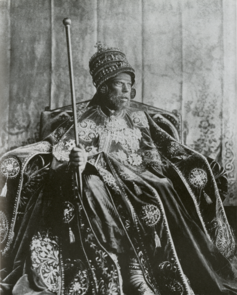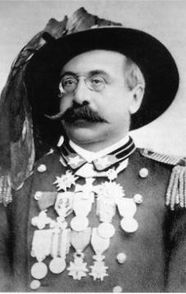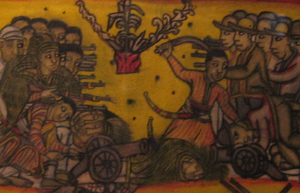الحرب الإيطالية الحبشية الأولى
| الحرب الإيطالية الحبشية الأولى | |||||||
|---|---|---|---|---|---|---|---|
 مع عقارب الساعة من أعلى اليسار: جنود إيطاليون في طريقهم إلى مصوع؛ قلعة يوحنس الرابع في Mek'ele;[1] Ethiopian cavalry at the Battle of Adwa; Italian prisoners are freed following the end of hostilities; Menelik II at Adwa; Ras Makonnen leading Ethiopian troops in the Battle of Amba Alagi | |||||||
| |||||||
| المتحاربون | |||||||
|
|
بدعم من: * | ||||||
| القادة والزعماء | |||||||
|
|
* | ||||||
| القوى | |||||||
| 18,000[3] | 120,000 (80-100,000 with firearms, rest with spears) [nb 1] | ||||||
| الضحايا والخسائر | |||||||
| 15,000 قتيل [3][5] | 17,000 قتيل [5] | ||||||
الحرب الإيطالية الحبشية الأولى First Italo-Ethiopian War وقد دارت بين إيطاليا و إثيوبيا 1895-1896.
قامت روسيا و فرنسا بدعم للقوات الإثيوبية بالأسلحة، وضباط الجيش، والإمدادات الطبية، مما أدى إلى انتصار الجيش الاثيوبي على إيطاليا، وأصبحت إثيوبيا الدولة الافريقية الوحيدة التي قاومت الاستعمار الأوروبي بنجاح خلال التدافع من أجل أفريقيا.
This was not the first African victory over Western colonizers, but it was the first time such a military put a definitive stop to a colonizing nation's efforts. According to one historian, "In an age of relentless European expansion, Ethiopia alone had successfully defended its independence".[6]
خلفية
On March 25, 1889, the Shewa ruler Menelik II, having conquered Tigray and Amhara, declared himself Emperor of Ethiopia (or "Abyssinia", as it was commonly called in Europe at the time). Barely a month later, on May 2, he signed the Treaty of Wuchale with the Italians, which apparently gave them control over Eritrea, the Red Sea coast to the northeast of Ethiopia, in return for recognition of Menelik's rule. Menelik II continued the policy of Tewodros I of integrating Ethiopia.
إلا أن المعاهدة ثنائية اللغة لم تقل نفس الأشياء بالإيطالية كتلك المكتوبة بالأمهرية؛ the Italian version did not give the Ethiopians the "significant autonomy" written into the Amharic translation.[7] The former text established an Italian protectorate over Ethiopia, but the Amharic version merely stated that Menelik could contact foreign powers and conduct foreign affairs through Italy if he so chose. Italian diplomats, however, claimed that the original Amharic text included the clause and Menelik knowingly signed a modified copy of the Treaty.[8]
Because of the Ethiopian refusal to abide by the Italian version of the treaty and despite economic handicaps at home, the Italian government decided on a military solution to force Ethiopia to abide by the Italian version of the treaty. In doing so, they believed that they could exploit divisions within Ethiopia and rely on tactical and technological superiority to offset any inferiority in numbers.
There was a broader, European background as well: the Triple Alliance of Germany, Austria–Hungary, and Italy was under some stress, with Italy being courted by England. Two secret Anglo-Italian protocols in 1891, left most of Ethiopia in Italy's sphere of influence.[9] France, one of the members of the opposing Franco-Russian Alliance, had its own claims on Eritrea and was bargaining with Italy over giving up those claims in exchange for a more secure position in Tunisia. Meanwhile, Russia was supplying weapons and other aid to Ethiopia.[7] It had been trying to gain a foothold in Ethiopia,[10] and in 1894, after denouncing the Treaty of Wuchale in July, it received an Ethiopian mission in St. Petersburg and sent arms and ammunition to Ethiopia.[11] This support continued after the war ended.[12]
المرحلة الافتتاحية
معركة عدوة
 مقالة مفصلة: معركة عدوة
مقالة مفصلة: معركة عدوة

حدثت عام 1896 عندما حاولت إيطاليا غزو إثيوپيا في محاولة للتحكم بمدخل البحر الأحمر بعد أن استولت بريطانيا على قناة السويس قبلها. استعان الإثيوبيون بأسلحة إنگليزية الصنع وبضباط إنگليز متقاعدين لتدريب القوات . وكانت هزيمة مدوية للعسكرية الإيطالية أذهلت العالم كله .
نهاية الحرب
النتائج
- كانت لهذة المعركة أهمية كبرى في الصراع بين القوى الإستعمارية على أفريقيا حيث كفلت سيادة بريطانية شبه كاملة على البحر الأحمر وشرق أفريقيا دون منغصات حقيقية من المنافسين .
- كفلت التوازنات السياسية بعد الحرب استقلالاً فريداً من نوعه لإثيوبيا إذ كانت الدولة الوحيدة ( إلى جانب ليبريا المحافظة على استقلالها في أفريقيا وقتئذ ) إلى أن غزتها بريطانيا بعد ذلك بعقود .
- كانت عدوة أول هزيمة عسكرية مؤثرة لقوة استعمارية أوربية على يد قوة غير أوربية منذ بدأ الاستعمار و قد أثرت كثيراً على معنويات سكان المستعمرات حيث قضت على أسطورة أن الأوربى لا يقهر ما ألهب الشعور الوطنى لدى الشعوب المحتلة أراضيها وأعطاهم الأنطباع بأن المقاومة ممكنة والتحرير ممكن.
- أظهرت معركة عدوة الحجم الحقيقي لإيطاليا كقوة استعمارية ما دفعها للتخلى عن كثير من أحلامها الأفريقية والاكتفاء بفتات المائدة.
صور
Russian military officer نيقولاي ليونتييڤ with a member of the Ethiopian military
Two Italian soldiers captured and held captive after the Battle of Adwa.
انظر أيضاً
- التجريدة على الحبشة 1868
- Battle of Dogali - 1887
- Second Italo-Abyssinian War - 1935-1936
- عسكرية إثيوپيا
- التاريخ العسكري لإثيوپيا
الهوامش
المصادر
- ^ "Ethiopian Treasures". ethiopiantreasures.co.uk. Retrieved 3 October 2015.
- ^ Robert G. Patman. The Soviet Union in the Horn of Africa: The Diplomacy of Intervention and Disengagement. Cambridge University Press, 2009.
- ^ أ ب Vandervort, Bruce. Wars of Imperial Conquest in Africa, 1830-1914. 1998, page 160
- ^ Pankhurst, The Ethiopians, p. 190
- ^ أ ب The Battle of Adwa: Reflections on Ethiopia's Historic Victory Against European Colonialism. 2005, page 71.
- ^ Jonas, Raymond (2011). The Battle of Adwa: African Victory in the Age of Empire. Harvard UP. p. 1. ISBN 9780674062795.
- ^ أ ب Gardner, Hall (2015). The Failure to Prevent World War I: The Unexpected Armageddon. Ashgate. p. 107. ISBN 9781472430588.
- ^ Piero Pastoretto. "Battaglia di Adua" (in الإيطالية). Archived from the original on May 31, 2006. Retrieved 2006-06-04.
- ^ Britain Gave Italy Rights Under Secret Pact in 1891 To Rule Most of Ethiopia, The New York Times, July 22, 1935
- ^ Burke, Edmund (1892). "East Africa". The Annual Register of World Events: A Review of the Year. Longmans, Green. pp. 397–. Retrieved 14 September 2015.
- ^ Vestal, Theodore M. (2005). "Reflections on the Battle of Adwa and its Significance for Today". In Paulos Milkias (ed.). The Battle of Adwa: Reflections on Ethiopia's Historic Victory Against European Colonialism. Getachew Metaferia. Algora. pp. 21–35. ISBN 9780875864143.
- ^ Eribo, Festus (2001). In Search of Greatness: Russia's Communications with Africa and the World. Greenwood. p. 55. ISBN 9781567505320.







